Westell D90327WXXX-06 4 Port Wireless Gateway Router User Manual wip120705
Westell Inc 4 Port Wireless Gateway Router wip120705
Westell >
users manual
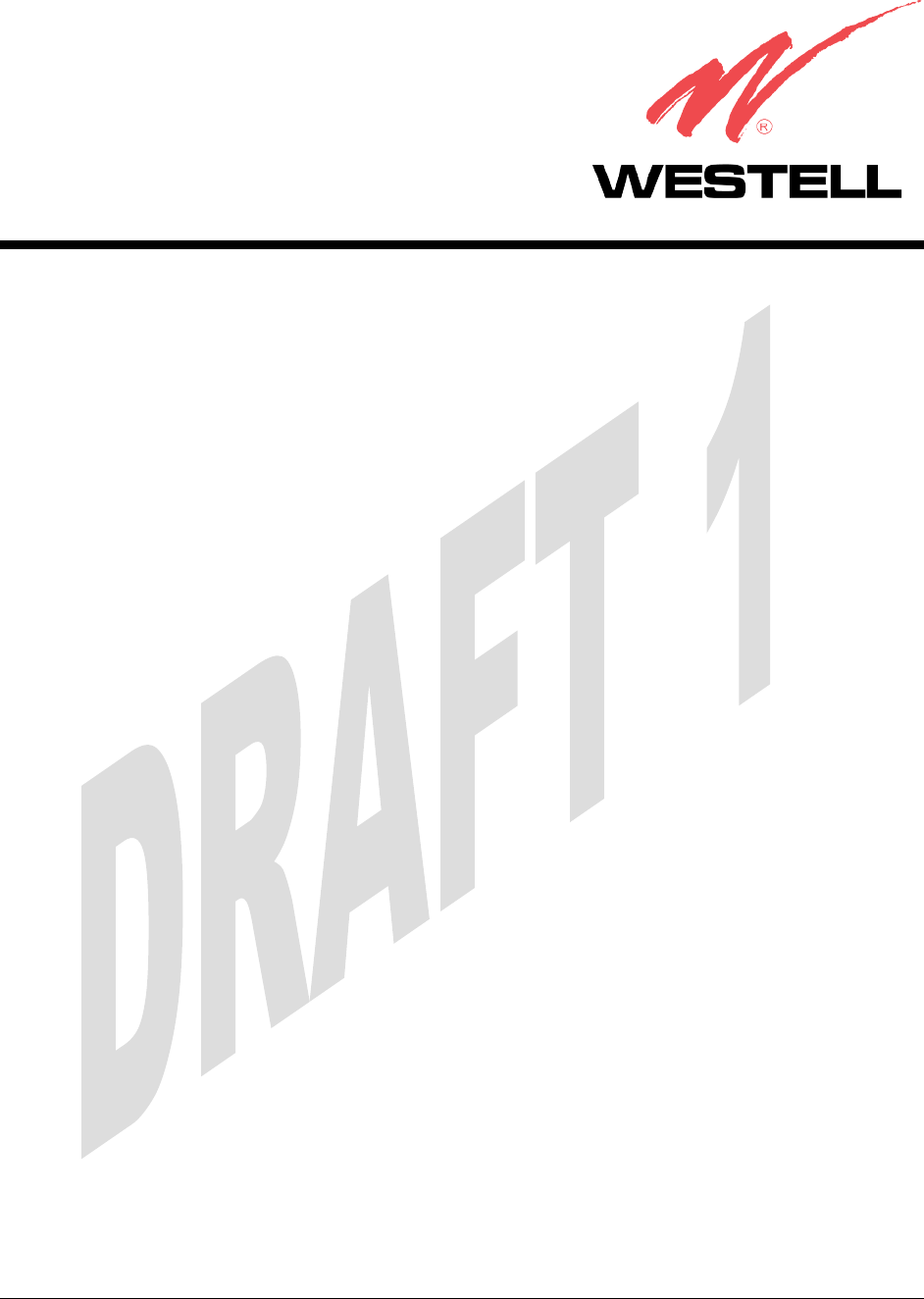
Copyright © 2005 Westell, Inc. 030-300469 Rev. A
VERSALINK™ GATEWAY (MODEL 327W)
USER GUIDE
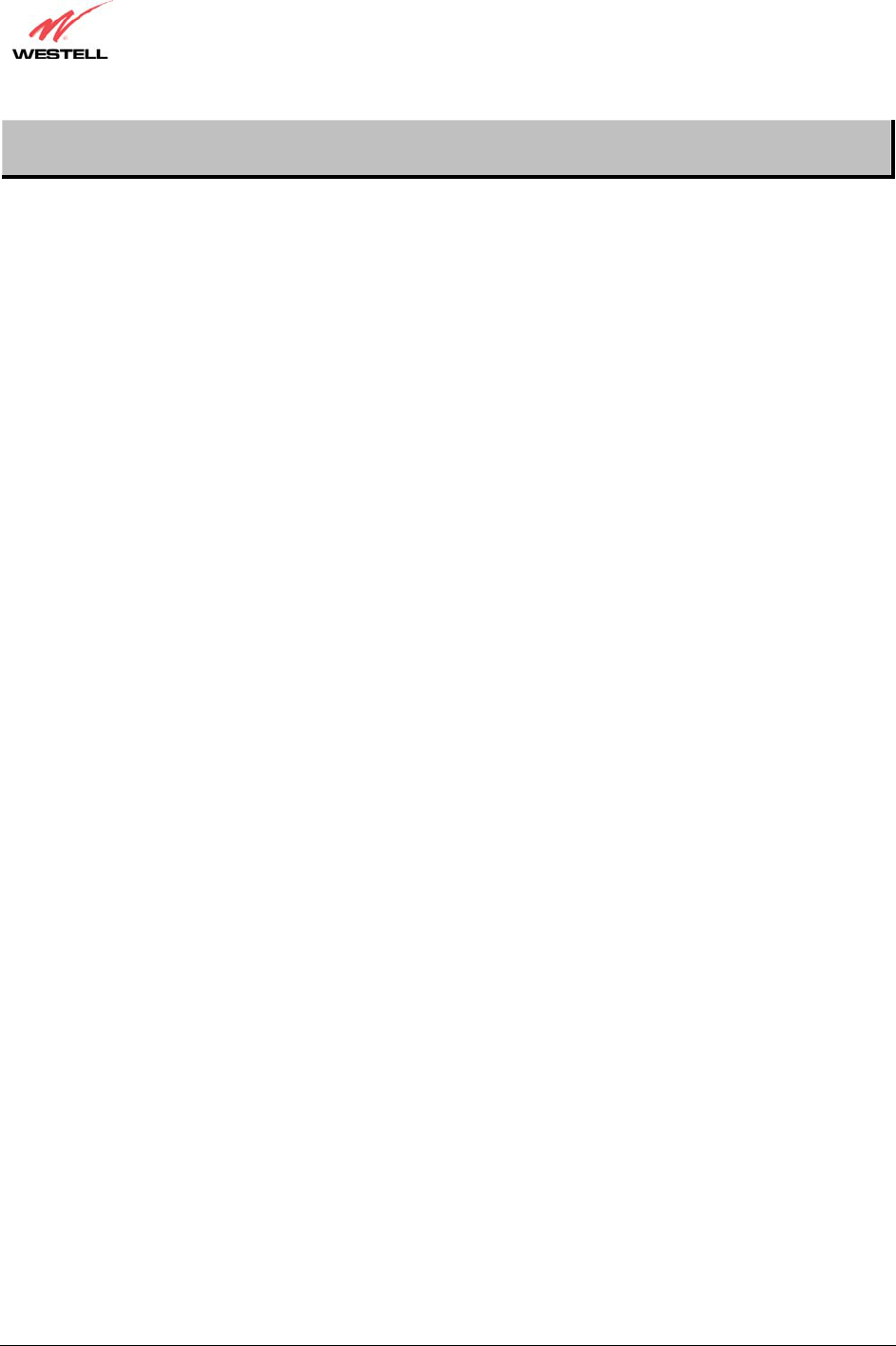
7/29/03 DRAFT 2
(030-300361)
030-300469 Rev. A 2 September 2005
Westell (Model 6000, 6100, 6110)
User Guide
TABLE OF CONTENTS
1. PRODUCT DESCRIPTION ..................................................................................................................................3
2. SAFETY INSTRUCTIONS ...................................................................................................................................3
3. REGULATORY INFORMATION ........................................................................................................................4
3.1 FCC Compliance Note...............................................................................................................................4
3.2 Canada Certification Notice.......................................................................................................................5
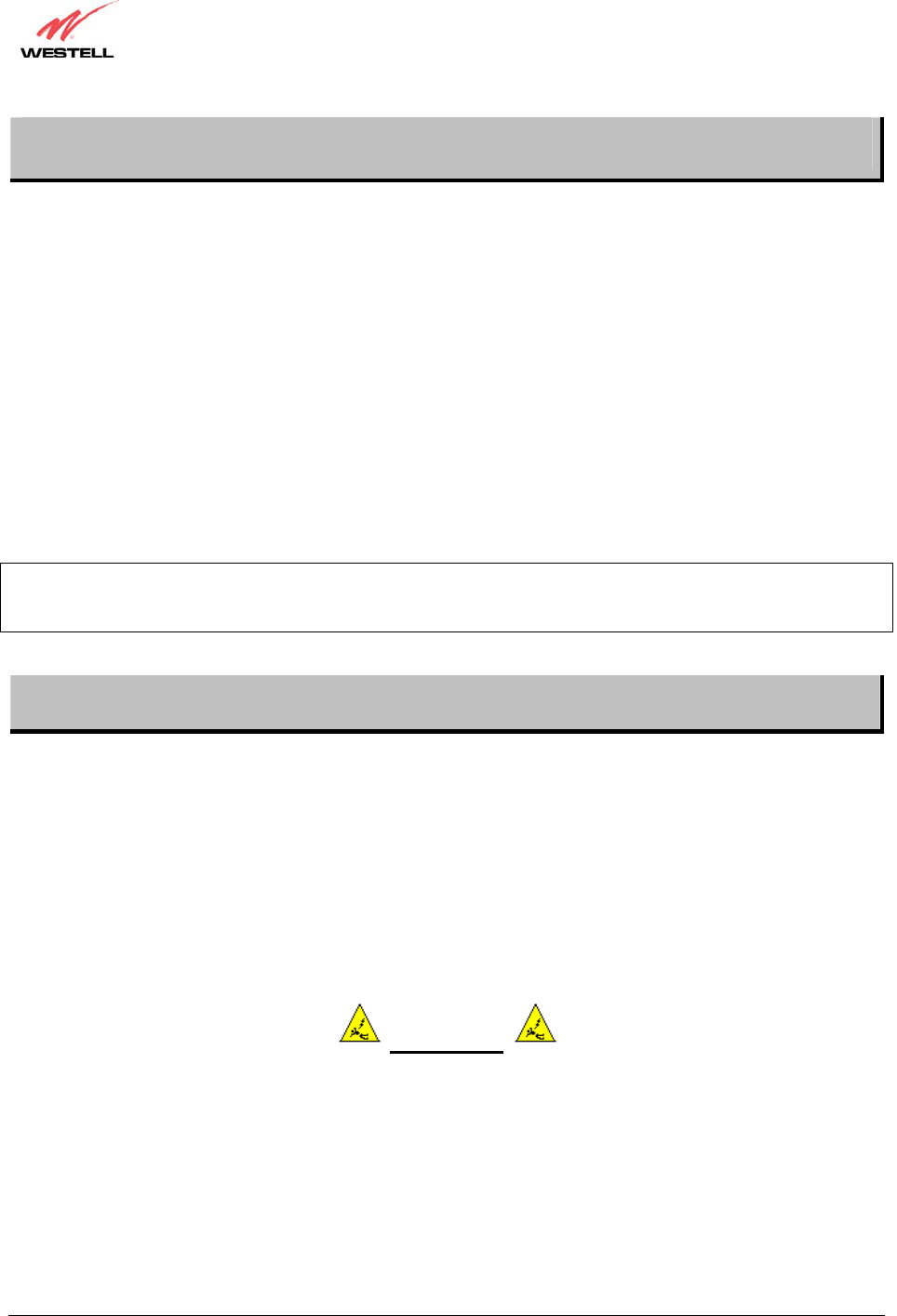
7/29/03 DRAFT 2
(030-300361)
030-300469 Rev. A 3 September 2005
Westell (Model 6000, 6100, 6110)
User Guide
1. PRODUCT DESCRIPTION
The Westell® VersaLink™ Gateway provides reliable, high-speed, Internet access to your existing small office
phone line. Your ADSL connection is “always-on” ending the hassles of dial-up modems and busy signals.
Installation is easy ... no tools ... no headaches. Simply connect the hardware, apply power, and perform the simple
software configuration for VersaLink and you are on the Internet.
VersaLink™ is capable of data rates hundreds of times faster than a traditional analog modem. But unlike analog
modems, VersaLink™ allows you to use the same phone line for simultaneous voice/fax communications and high-
speed Internet access, eliminating the need for dedicated phone lines for voice and data needs. VersaLink™
supports a variety of networking interfaces such as wireless 802.11b/g/g+, ADSL, Ethernet and the following
optional features:
• VersaPort™: Alternate WAN uplink port
• Layer w/2 QOS with VLAN tagging
• HotSpot
• Simultaneous public/private network support
Hereafter, the Westell® VersaLink™ Gateway will be referred to as “VersaLink” or “Gateway.” There are two
versions of the VersaLink: one with a USB port and one without a USB port. Features may vary depending on the
model. Refer to section Error! Reference source not found. for model differences.
2. SAFETY INSTRUCTIONS
• Never install any telephone wiring during a lightning storm.
• Never install telephone jacks in wet locations unless the jack is specifically designed for wet locations.
• Never touch non-insulated telephone wires or terminals unless the telephone line has been disconnected at the
network interface.
• Use caution when installing or modifying telephone lines.
WARNING
Risk of electric shock. Voltages up to 140 Vdc (with reference to
ground) may be present on telecommunications circuits.
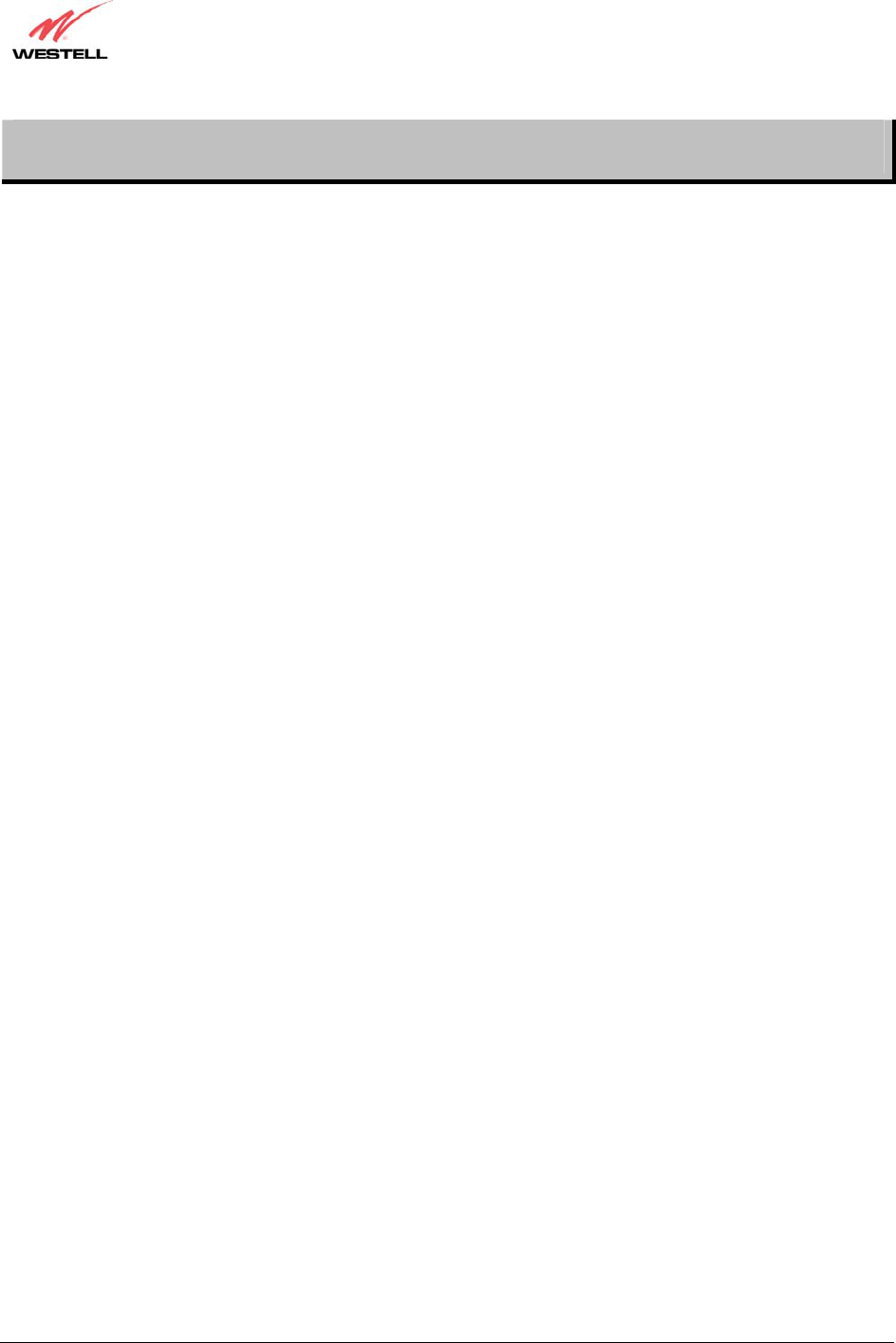
7/29/03 DRAFT 2
(030-300361)
030-300469 Rev. A 4 September 2005
Westell (Model 6000, 6100, 6110)
User Guide
3. REGULATORY INFORMATION
3.1 FCC Compliance Note
(FCC ID: CH8D90327WXX-06)
This equipment has been tested and found to comply with the limits for a Class B digital device, pursuant to Part 15
of the Federal Communication Commission (FCC) Rules. These limits are designed to provide reasonable protection
against harmful interference in a residential installation. This equipment generates, uses, and can radiate radio
frequency energy, and if not installed and used in accordance with the instructions, may cause harmful interference
to radio communications. However, there is no guarantee that interference will not occur in a particular installation.
If this equipment does cause harmful interference to radio or television reception, which can be determined by
turning the equipment OFF and ON, the user is encouraged to try to correct the interference by one or more of the
following measures:
• Reorient or relocate the receiving antenna.
• Increase the separation between the equipment and the receiver.
• Connect the equipment to a different circuit from that to which the receiver is connected.
• Consult the dealer or an experienced radio/TV technician for help.
This device complies with Part 15 of the FCC Rules. Operation is subject to the following two conditions: (1) This
device may not cause harmful interference, and (2) this device must accept any interference received, including
interference that may cause undesired operation.
The antennas used for this transmitter must be installed to provide a separation distance of at least 20 cm from all
persons and must not be co-located or operating in conjunction with any other antenna or transmitter. End users and
installers must be provided with antenna installation instructions and transmitter operating conditions for satisfying
RF exposure compliance.
Modifications made to the product, unless expressly approved by Westell Inc., could void the users’ right to
operate the equipment.
PART 68 – COMPLIANCE REGISTRATION
This equipment (Model 327W) complies with Part 68 of the FCC rules and the requirements adopted by the ACTA.
A label on the bottom of this equipment contains, among other information, the Ringer Equivalence Number (REN)
and the product identifier. For products approved after July 23, 2001 the product identifier is in the format
US:AAAEQ##TXXXX. The digits represented by ## are the REN without a decimal point (e.g. 03 is a REN of 0.3).
The REN is used to determine the number of devices that may be connected to a telephone line. For earlier products,
the REN is separately shown on the label. If requested, this number must be provided to the telephone company.
Excessive RENs on a telephone line may result in the devices not ringing in response to an incoming call. In most,
but not all areas, the sum of RENs should not exceed five (5.0). To be certain of the number of devices that may be
connected to a line, as determined by the total RENs, contact the local telephone company.
This equipment is designated to connect to the telephone network or premises wiring using a compatible modular
jack that is Part 68 compliant. An FCC compliant telephone cord and modular plug is provided with the equipment.
See the Installation Information section of this User Guide for details.

7/29/03 DRAFT 2
(030-300361)
030-300469 Rev. A 5 September 2005
Westell (Model 6000, 6100, 6110)
User Guide
A plug and jack used to connect this equipment to the premises wiring and telephone network must comply with the
applicable FCC Part 68 rules and requirements adopted by the ACTA. A compliant telephone cord and modular plug
is provided with this product. It is designed to be connected to a compatible modular jack that is also compliant. See
installation instruction for details.
If this terminal equipment (Model 327W) causes harm to the telephone network, the telephone company may
request you to disconnect the equipment until the problem is resolved. The telephone company will notify you in
advance if temporary discontinuance of service is required. If advance notification is not practical, the telephone
company will notify you as soon as possible. You will be advised of your right to file a complaint with the FCC if
you believe such action is necessary. If you experience trouble with this equipment (Model 327W), do not try to
repair the equipment yourself. The equipment cannot be repaired in the field. Contact your ISP, or contact the
original provider of your DSL equipment.
The telephone company may make changes to their facilities, equipment, operations, or procedures that could affect
the operation of this equipment. If this happens, the telephone company will provide advance notice in order for you
to make the modifications necessary to maintain uninterrupted service.
If your home has specially wired alarm equipment connected to the telephone line, ensure that the installation of this
equipment (Model 327W) does not disable your alarm equipment. If you have questions about what will disable
alarm equipment, consult your telephone company or a qualified installer.
This equipment cannot be used on public coin phone service provided by the telephone company. Connection of this
equipment to party line service is subject to state tariffs.
3.2 Canada Certification Notice
The Industry Canada label identifies certified equipment. This certification means that the equipment meets certain
telecommunications network protective, operations and safety requirements as prescribed in the appropriate
Terminal Equipment Technical Requirements document(s). The department does not guarantee the equipment will
operate to the user’s satisfaction.
This equipment meets the applicable Industry Canada Terminal Equipment Technical Specification. This is
confirmed by the registration number. The abbreviation, IC, before the registration number signifies that registration
was performed based on a Declaration of Conformity indicating that Industry Canada technical specification were
met. It does not imply that Industry Canada approved the equipment. The Ringer Equivalence Number (REN) is 0.0.
The Ringer Equivalence Number that is assigned to each piece of terminal equipment provides an indication of the
maximum number of terminals allowed to be connected to a telephone interface. The termination on an interface
may consist of any combination of devices subject only to the requirement that the sum of the Ringer Equivalence
Numbers of all the devices does not exceed five.
Before installing this equipment, users should ensure that it is permissible to be connected to the facilities of the
local Telecommunication Company. The equipment must also be installed using an acceptable method of
connection. The customer should be aware that compliance with the above conditions may not prevent degradation
of service in some situations. Connection to a party line service is subject to state tariffs. Contact the state public
utility commission, public service commission, or corporation commission for information.
If your home has specially wired alarm equipment connected to the telephone line, ensure that the installation of this
equipment (Model 327W) does not disable your alarm equipment. If you have questions about what will disable
alarm equipment, consult your telephone company or a qualified installer.
If you experience trouble with this equipment (Model 327W) do not try to repair the equipment yourself. The
equipment cannot be repaired in the field and must be returned to the manufacturer. Repairs to certified equipment
should be coordinated by a representative, and designated by the supplier. Refer to section Error! Reference source
not found. in this User Guide for further details. The termination on an interface may consist of any combination of
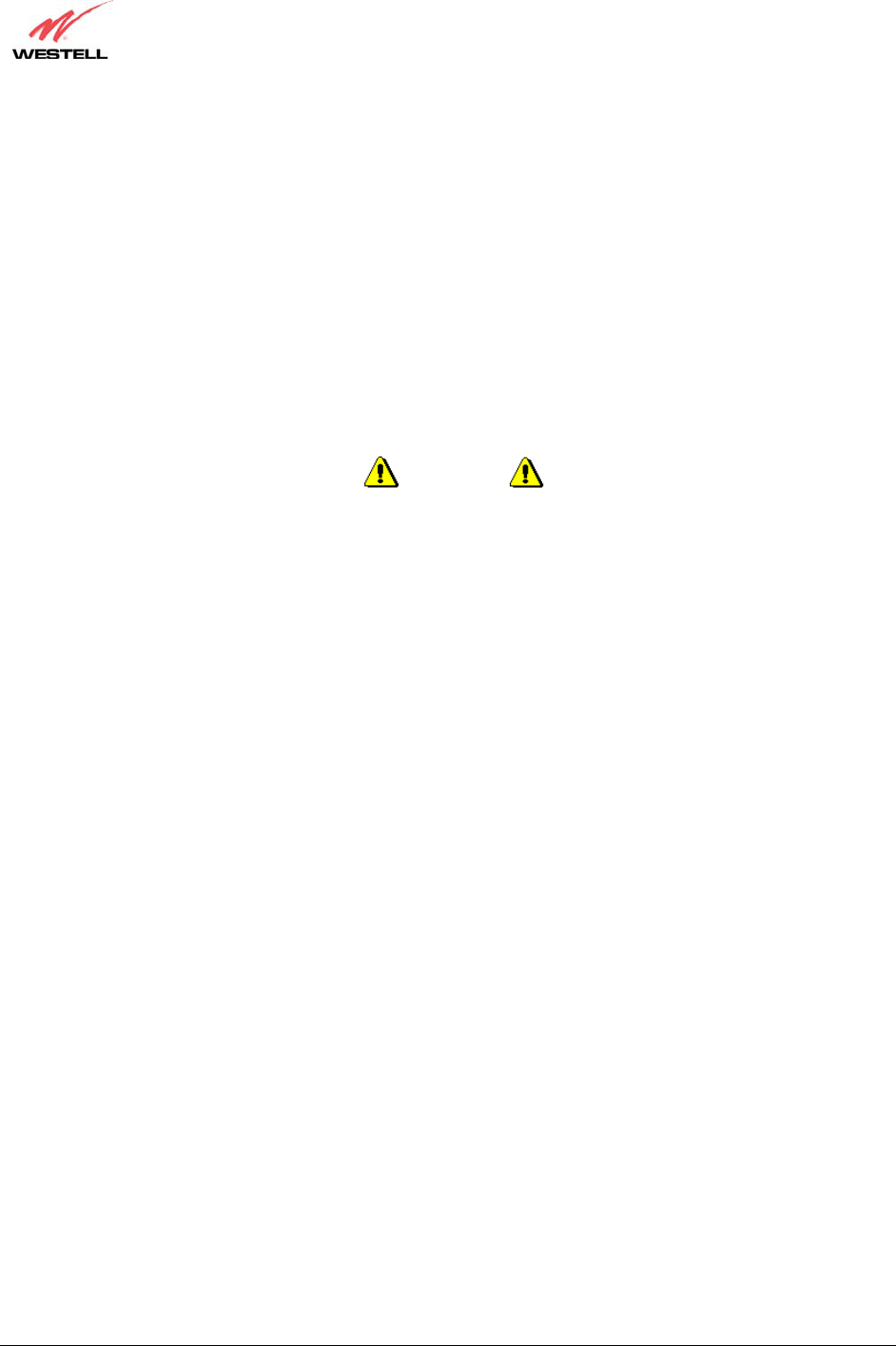
7/29/03 DRAFT 2
(030-300361)
030-300469 Rev. A 6 September 2005
Westell (Model 6000, 6100, 6110)
User Guide
devices subject only to the requirement that the sum of the Ringer Equivalence Numbers of all the devices does not
exceed five.
Operation of this equipment (Model 327W) is subject to the following conditions: (1) This device may not cause
harmful interference, and (2) This equipment must accept any interference received, including interference that may
cause undesired operation.
To reduce potential radio interference to users when a detachable antenna is used with this equipment the antenna
type and its gain should be so chosen that the equivalent isotropically radiated power (EIRP) is not more than that
required for successful communication.”
Users should ensure, for their own protection, that the electrical ground connections of the power utility, telephone
lines, and internal, metallic water pipe system, if present, are connected together. This precaution may be
particularly important in rural areas.
CAUTION
Users should not attempt to make such connections themselves, but should contact the
appropriate electrical inspection authority, or electrician, as appropriate.